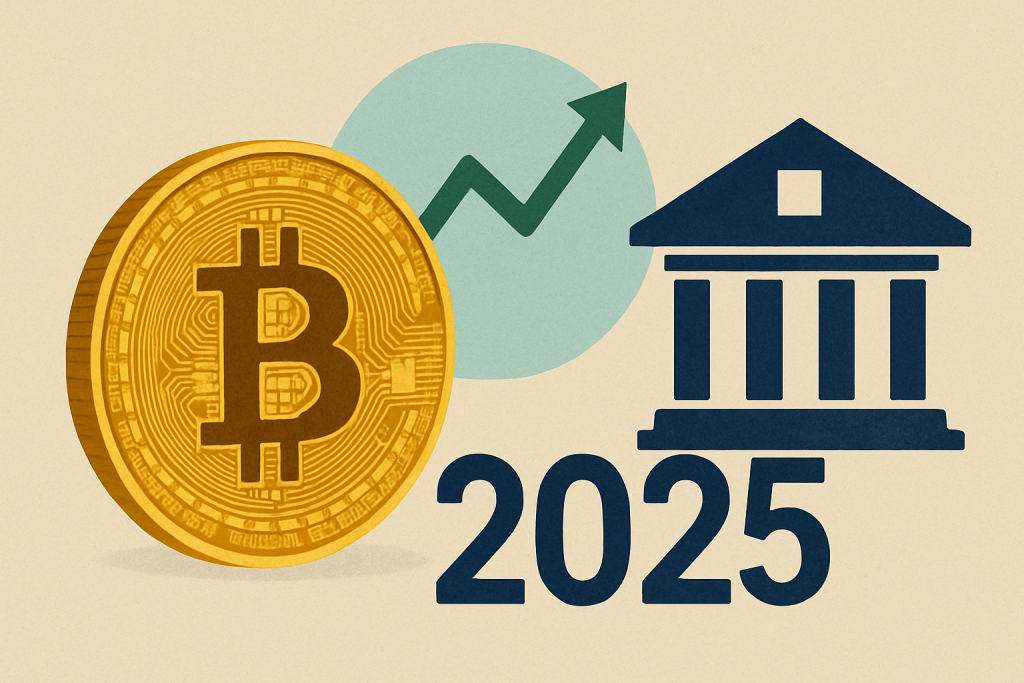Introduction
The cryptocurrency market has entered a phase of revitalization, marked by a significant surge in Bitcoin prices that has captured the attention of both retail investors and institutional players. In a detailed assessment, Deutsche Bank has outlined five critical takeaways from the ongoing rally that could shape the trajectory of the crypto sector for years to come. Bitcoin’s price, climbing over seventy percent since November, has broken past major resistance levels and now trades comfortably above one hundred and twenty thousand US dollars. This performance is not just a speculative spike but is underpinned by foundational shifts in market dynamics, regulatory developments, and structural maturity that indicate a longer-term evolution of the cryptocurrency landscape.
The latest rally, in Deutsche Bank’s view, is not simply the result of hype or short-term events. Instead, it represents a confluence of favorable factors, such as institutional investment via spot ETFs, legislative progress in the United States, and shifting investor perception of digital assets. Each of these elements provides insight into where Bitcoin and the broader digital asset ecosystem might be headed and what that means for traditional finance and global markets.
Institutional Investment Through ETFs Reshapes Market Foundations
One of the most significant forces propelling Bitcoin’s current rally is the influx of institutional capital through exchange-traded funds. Deutsche Bank emphasizes that the approval and widespread adoption of spot Bitcoin ETFs have legitimized the asset class among traditional investors. BlackRock’s iShares Bitcoin Trust, along with other leading ETF products, has attracted tens of billions of dollars in inflows, a signal that large financial institutions are no longer hesitant to offer crypto exposure to their clients. In 2025 alone, ETF inflows have surpassed fifty billion dollars, with projections indicating further acceleration.
This institutional adoption brings with it enhanced market stability and volume. The liquidity provided by ETFs smooths out volatility, narrows spreads, and reduces the impact of whale activity. Moreover, ETFs allow investors to gain exposure to Bitcoin without directly holding the asset, addressing long-standing concerns around custody, private key management, and hacking risks. These developments are creating a more robust, regulated, and accessible pathway to Bitcoin, drawing in pension funds, endowments, and asset managers that were previously skeptical.
Regulatory Clarity In The United States Spurs Confidence
The United States government has played a pivotal role in boosting investor confidence in cryptocurrencies through the advancement of comprehensive legislation. Deutsche Bank points out that the recent passage of key bills—particularly the GENIUS Act and the Digital Asset Market Clarity Act—has established a clearer legal framework for the operation and trading of digital assets. These laws delineate the responsibilities of the Securities and Exchange Commission and the Commodity Futures Trading Commission, thus eliminating the jurisdictional confusion that plagued the industry in previous years.
The regulatory structure now provides more predictability and transparency, which is crucial for institutional players. Without regulatory uncertainty, risk managers and compliance departments are more likely to approve crypto-related strategies. The new legal framework also outlines requirements for stablecoin reserves and audits, and it sets a path for the creation of compliant digital financial products. The clarity offered by these legislative advancements has made the United States a more attractive jurisdiction for crypto businesses and investors alike.
Bitcoin As A Macro Asset In Portfolio Construction
Another key takeaway highlighted by Deutsche Bank is Bitcoin’s evolving role in macroeconomic portfolio strategy. Institutional investors are increasingly viewing Bitcoin not as a fringe asset or speculative tool but as a potential hedge against inflation, monetary debasement, and systemic risks within traditional financial systems. This shift is critical, as it positions Bitcoin alongside traditional hedges like gold and Treasury Inflation-Protected Securities in asset allocation models.
The bank notes that macroeconomic instability in several parts of the world, especially in high-inflation economies, has driven renewed interest in decentralized assets. In countries facing currency depreciation or restrictive capital controls, Bitcoin is seen as a secure store of value. Moreover, Bitcoin’s scarcity, underpinned by its fixed supply of twenty-one million coins, is driving narratives around digital gold and long-term wealth preservation. These factors support the thesis that Bitcoin is no longer merely a speculative play but a strategic asset within diversified portfolios.
Maturing Infrastructure And Market Mechanisms
Deutsche Bank also highlights the significant improvements in crypto market infrastructure as a factor in Bitcoin’s sustained rally. Over the past two years, exchanges have enhanced their compliance protocols, risk management systems, and technical architectures. The integration of institutional-grade custodial services, real-time settlement layers, and robust security frameworks has attracted more conservative investors who demand high operational standards.
In addition to spot ETF availability, the proliferation of futures markets, options products, and interest-bearing crypto instruments provides a wide array of financial tools for portfolio managers. These mechanisms allow for sophisticated trading strategies, hedging, and income generation, which align with institutional investment mandates. Moreover, the integration of crypto assets into traditional trading platforms through APIs and financial software suites streamlines access for investment professionals.
The role of decentralized finance is also maturing. Although still in development, DeFi now includes more compliant and secure platforms that offer yield farming, decentralized exchanges, and lending with greater transparency and regulatory oversight. As these platforms adopt know-your-customer policies and smart contract audits, their role in the overall financial ecosystem is becoming more significant and less risky.
Investor Sentiment And Global Adoption Trends
The final long-term takeaway centers around shifting investor sentiment and growing global adoption. Deutsche Bank’s analysis suggests that mainstream sentiment toward Bitcoin has fundamentally changed. The stigma that once surrounded cryptocurrencies as tools for illicit finance or unstable speculation has largely been replaced by recognition of their technological and financial potential. This change is visible in both retail and institutional spaces, with digital asset literacy increasing across generations and geographies.
Emerging markets continue to be strong drivers of adoption. Countries in Latin America, Southeast Asia, and Africa have seen a spike in peer-to-peer Bitcoin transactions, mobile crypto wallets, and local startups building blockchain solutions. In these regions, crypto adoption is driven by necessity rather than speculation. Economic instability, restricted banking access, and a lack of financial infrastructure make Bitcoin and stablecoins essential tools for saving, remittance, and commerce.
Western economies, too, are seeing broader adoption across sectors. Financial institutions, corporations, and even governments are experimenting with blockchain-based systems for settlement, identity, and supply chain management. Retailers now offer crypto payments as a standard option, and mainstream financial apps integrate Bitcoin alongside stocks and bonds. This normalization of crypto in daily financial interactions is reshaping public perception and embedding digital assets into the core of economic activity.
Looking Ahead: Bitcoin Beyond The 2025 Rally
As the crypto market continues its upward trajectory, Deutsche Bank’s analysis offers a lens through which investors and policymakers can assess the durability and legitimacy of the current rally. The integration of Bitcoin into mainstream financial systems is no longer theoretical; it is unfolding in real time. With strong ETF inflows, clearer regulations, and expanding infrastructure, Bitcoin’s current rally reflects more than short-term enthusiasm. It signals the consolidation of cryptocurrency into the fabric of global finance.
There remain challenges, of course. Issues around environmental sustainability, energy usage, cybersecurity, and the scalability of blockchain networks are still being addressed. Likewise, regulatory alignment across jurisdictions remains inconsistent. However, the progress made in the past year demonstrates that the crypto industry is capable of evolving rapidly and aligning with institutional expectations.
Conclusion
Bitcoin’s powerful rally in 2025 is not an isolated market anomaly but a reflection of deeper, systemic shifts occurring in the financial world. As Deutsche Bank has outlined, the forces behind this rally—such as institutional ETF inflows, comprehensive regulatory clarity, the adoption of Bitcoin as a macro asset, maturing infrastructure, and rising global adoption—are collectively reshaping how digital assets are perceived and utilized. This transformation is moving Bitcoin beyond the realm of speculation and into the architecture of the broader financial system.



